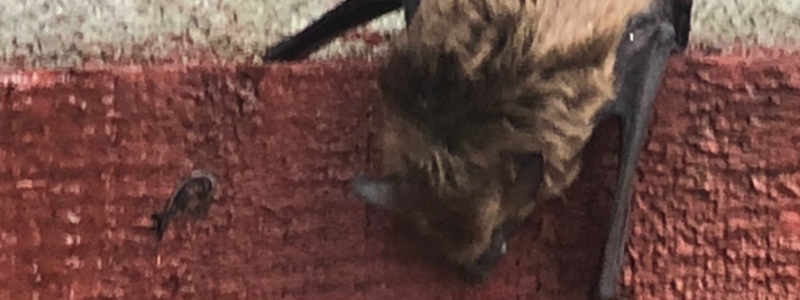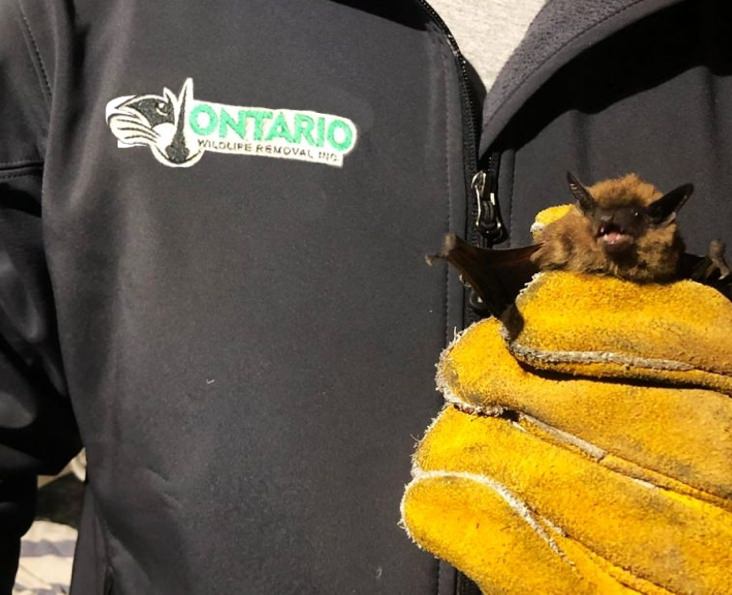
What To Do If There’s a Bat Flying In Your House
Posted by Jared Houliston Sunday, February 20th, 2022 | 20,282 Reads
Every year we get a huge number of calls for help removing a bat that’s flying in their house. The following steps that will help you get a bat out safely and humanely.
Make sure to read this article in it’s entirety so you do everything right when it comes to handling bats.
Bats in the common areas of your home
To begin with, if there is a bat in the common area of your home, do not kill it. Bats are a protected species and in Canada it’s against the law to kill them under most circumstances. Currently certain bats are endangered in Canada and there are 8 species of bats that are designated as Specially Protected Mammals. Click here for the list of which bats are protected.
Be careful because bats can carry rabies
 Also, bats can carry rabies which is deadly to humans. If a bat is flying in your house, the best way to avoid getting bit by it is to remain calm and call a wildlife removal specialist immediately.
Also, bats can carry rabies which is deadly to humans. If a bat is flying in your house, the best way to avoid getting bit by it is to remain calm and call a wildlife removal specialist immediately.
If however, you decide to remove the bat yourself take the following steps:
- Stay calm and reduce all commotion
- Get your children and pets out of the room
- Check to see if anyone has been bit by the bat
- Open the window so the bat can leave
- Close doors of the room so it can’t fly around the house
- Put on thick clothing and gloves so you don’t get bit
- Use a thick towel to capture it and put it in a plastic container
- Prod the bat outside or put outside yourself and call a wildlife rehab centre
Remain very calm
While you’re trying to remove the bat, it may be flying around. If it does fly, just remain calm—even if it looks like it will fly into you. Bats use ultrasound waves that vibrate at 20,000 vibrations per second which enables them to ‘see’ objects just as accurately as we can with our eyes. Bat calls can be translated into forms humans can see and hear.
If anyone was bit by the bat
If you or someone in your household appears to have been bit by the bat you are advised to thoroughly wash the wound for 15 minutes with soap and water. While the person that was bit is washing the wound, someone should call the Ontario TeleHealth and explain to them what happened.
We also strongly advise that you also go to the hospital immediately and have your situation assessed by a doctor. Once clinical symptoms of rabies appear, rabies is virtually 100% fatal.
The common areas of the body that bats bite people are the arms, wrists, hands, neck or ears—generally any exposed skin. Even before attempting to remove the bat, check yourself and your whole family for bites. Bat bites are very small and look like tiny scratches so if anyone has a new scratch on their body its wise to get them to the hospital.
Locate, capture and remove the bat
First, do not attempt the following if it is in the winter.
Put on some thick glovers, locate the bat and try to capture it with the towel. If it continues to fly away as you approach, keep trying. Eventually the bat will get tired and rest for longer periods of time and enable you to scoop it up gently with the towel. From there you can bring it to the window or out your front door.
When releasing the bat from the towel, just open it or release your grip slowly. Eventually it will fly away on its own.
If you found the bat in the winter
Bats hibernate in the winter but sometimes they wake up from their hibernation and wander into the home’s living quarters. In such cases, you cannot simply capture the bat and release it outside.
If you find a bat in your home in the winter and are able to capture it, put it in a safe box with a cover and call a local wildlife rehabilitation service. They will give you specific instructions on what to do with the bat next and may have you deliver it to them too.
If the bat is injured
If the bat is injured, place it in a small box or Tupperware container with a lid on top of it just as you would if you found it in the winter. Then call a local wildlife rehabilitation centre in your area. There are many wildlife refuge centre throughout Ontario so it should be easy to find one.
The wildlife rehabilitation centre you call will take the injured bat and nurture it back to health. Once it’s properly recovered they will release it back into the wild once it’s ready to survive on its own.
If you can’t catch the bat, call a bat removal specialist
If nothing you tried worked and you can’t get the bat out of your home, call a wildlife removal specialist. They’re specially trained in bat removal and will humanely capture the bat and deal with it appropriately.
When they arrive, they’ll assess the situation, give you a quick quote, capture the bat, and humanely remove it from your home.
What Should I Do After The Bat is Removed?
Have your attic inspected
After the bat is removed from your home, it would be a good idea to have your attic inspected. If you had a bat in your home it’s likely that bats are living in your attic too. They could have flown into your home from the outside or came down to your common area through some path from your attic. A bat removal company will inspect your house for entry points and other signs of bats.
An inspection will tell you if you have a bat problem and if you do, you’ll have to get them removed. After the removal, you’ll be advices to have exclusion measures are installed. Exclusion is not required but it ensures bats and other forms of wildlife can’t get back into your attic in the future.
Catching an infestation early
An infestation that is not caught early is usually the cause of a bat flying in the home, can dangerous to your health and severely damage your attic. If you decide to inspect for bats yourself, the following link will help you find the signs and explain what to do if you find them. It will provide you tips on how they are getting into your home, and what you can do to prevent it.
Ontario Wildlife Removal Inc. provides wildlife removal and pest control in Southwestern Ontario, including Brantford, Kitchener-Waterloo, Cambridge, Guelph, London, Woodstock, Tillsonburg, Simcoe, Port Dover, Paris, St. George, Six Nations, Caledonia, Burlington, Waterdown, Oakville, Hamilton, Stoney Creek, Grimsby, & Niagara Region. Our methods are safe, humane and environmentally friendly. Call today to book your inspection.
Get a Pest Control Quote
Simply fill in your details below and we'll call you very shortly to discuss your issues.





Leave a Reply